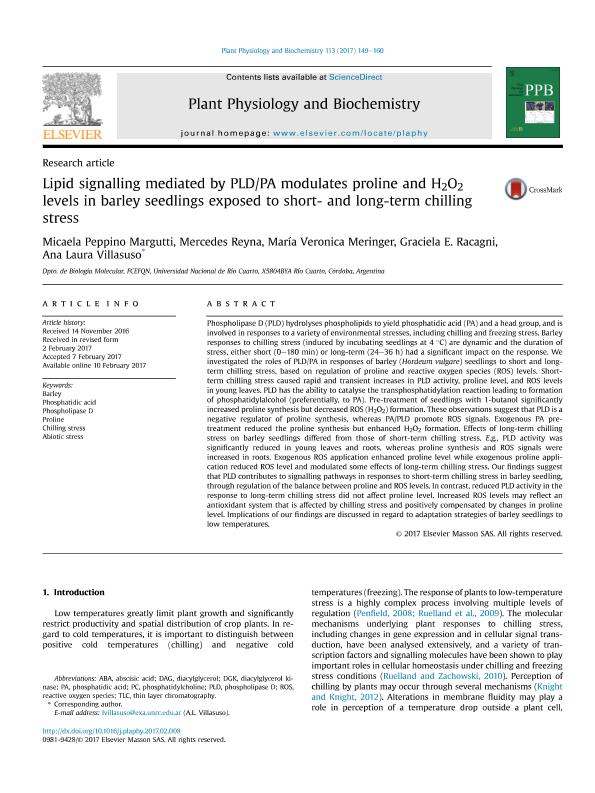Mostrar el registro sencillo del ítem
dc.contributor.author
Peppino Margutti, Micaela Yesica

dc.contributor.author
Reyna, Mercedes

dc.contributor.author
Meringer, Maria Veronica

dc.contributor.author
Racagni, Graciela Esther

dc.contributor.author
Villasuso, Ana Laura

dc.date.available
2019-04-29T14:46:56Z
dc.date.issued
2017-04
dc.identifier.citation
Peppino Margutti, Micaela Yesica; Reyna, Mercedes; Meringer, Maria Veronica; Racagni, Graciela Esther; Villasuso, Ana Laura; Lipid signalling mediated by PLD/PA modulates proline and H2O2 levels in barley seedlings exposed to short- and long-term chilling stress; Elsevier France-Editions Scientifiques Medicales Elsevier; Plant Physiology and Biochemistry; 113; 4-2017; 149-160
dc.identifier.issn
0981-9428
dc.identifier.uri
http://hdl.handle.net/11336/75202
dc.description.abstract
Phospholipase D (PLD) hydrolyses phospholipids to yield phosphatidic acid (PA) and a head group, and is involved in responses to a variety of environmental stresses, including chilling and freezing stress. Barley responses to chilling stress (induced by incubating seedlings at 4 °C) are dynamic and the duration of stress, either short (0–180 min) or long-term (24–36 h) had a significant impact on the response. We investigated the roles of PLD/PA in responses of barley (Hordeum vulgare) seedlings to short and long-term chilling stress, based on regulation of proline and reactive oxygen species (ROS) levels. Short-term chilling stress caused rapid and transient increases in PLD activity, proline level, and ROS levels in young leaves. PLD has the ability to catalyse the transphosphatidylation reaction leading to formation of phosphatidylalcohol (preferentially, to PA). Pre-treatment of seedlings with 1-butanol significantly increased proline synthesis but decreased ROS (H2O2) formation. These observations suggest that PLD is a negative regulator of proline synthesis, whereas PA/PLD promote ROS signals. Exogenous PA pre-treatment reduced the proline synthesis but enhanced H2O2 formation. Effects of long-term chilling stress on barley seedlings differed from those of short-term chilling stress. E.g., PLD activity was significantly reduced in young leaves and roots, whereas proline synthesis and ROS signals were increased in roots. Exogenous ROS application enhanced proline level while exogenous proline application reduced ROS level and modulated some effects of long-term chilling stress. Our findings suggest that PLD contributes to signalling pathways in responses to short-term chilling stress in barley seedling, through regulation of the balance between proline and ROS levels. In contrast, reduced PLD activity in the response to long-term chilling stress did not affect proline level. Increased ROS levels may reflect an antioxidant system that is affected by chilling stress and positively compensated by changes in proline level. Implications of our findings are discussed in regard to adaptation strategies of barley seedlings to low temperatures.
dc.format
application/pdf
dc.language.iso
eng
dc.publisher
Elsevier France-Editions Scientifiques Medicales Elsevier

dc.rights
info:eu-repo/semantics/openAccess
dc.rights.uri
https://creativecommons.org/licenses/by-nc-sa/2.5/ar/
dc.subject
Abiotic Stress
dc.subject
Barley
dc.subject
Chilling Stress
dc.subject
Phosphatidic Acid
dc.subject
Phospholipase D
dc.subject
Proline
dc.subject.classification
Otras Ciencias Biológicas

dc.subject.classification
Ciencias Biológicas

dc.subject.classification
CIENCIAS NATURALES Y EXACTAS

dc.title
Lipid signalling mediated by PLD/PA modulates proline and H2O2 levels in barley seedlings exposed to short- and long-term chilling stress
dc.type
info:eu-repo/semantics/article
dc.type
info:ar-repo/semantics/artículo
dc.type
info:eu-repo/semantics/publishedVersion
dc.date.updated
2019-04-16T20:39:34Z
dc.journal.volume
113
dc.journal.pagination
149-160
dc.journal.pais
Francia

dc.description.fil
Fil: Peppino Margutti, Micaela Yesica. Consejo Nacional de Investigaciones Científicas y Técnicas. Centro Científico Tecnológico Conicet - Córdoba; Argentina. Universidad Nacional de Río Cuarto. Facultad de Ciencias Exactas, Fisicoquímicas y Naturales. Departamento de Biología Molecular. Sección Química Biológica; Argentina
dc.description.fil
Fil: Reyna, Mercedes. Universidad Nacional de Río Cuarto. Facultad de Ciencias Exactas Fisicoquímicas y Naturales. Departamento de Biología Molecular; Argentina. Consejo Nacional de Investigaciones Científicas y Técnicas. Centro Científico Tecnológico Conicet - Córdoba; Argentina
dc.description.fil
Fil: Meringer, Maria Veronica. Consejo Nacional de Investigaciones Científicas y Técnicas. Centro Científico Tecnológico Conicet - Córdoba; Argentina. Universidad Nacional de Río Cuarto. Facultad de Ciencias Exactas Fisicoquímicas y Naturales. Departamento de Biología Molecular; Argentina
dc.description.fil
Fil: Racagni, Graciela Esther. Universidad Nacional de Río Cuarto; Argentina
dc.description.fil
Fil: Villasuso, Ana Laura. Consejo Nacional de Investigaciones Científicas y Técnicas. Centro Científico Tecnológico Conicet - Córdoba; Argentina. Universidad Nacional de Río Cuarto. Facultad de Ciencias Exactas Fisicoquímicas y Naturales. Departamento de Biología Molecular; Argentina
dc.journal.title
Plant Physiology and Biochemistry

dc.relation.alternativeid
info:eu-repo/semantics/altIdentifier/url/https://www.sciencedirect.com/science/article/pii/S098194281730058X
dc.relation.alternativeid
info:eu-repo/semantics/altIdentifier/doi/http://dx.doi.org/10.1016/j.plaphy.2017.02.008
Archivos asociados
